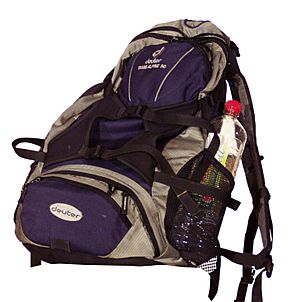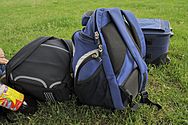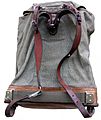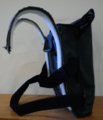Backpack facts for kids
A backpack is a bag you wear on your back. It usually has two straps that go over your shoulders. People use backpacks to carry many different things. They often have several compartments to help keep things organized.
Backpacks are great for outdoor activities. People use them for camping trips and hikes. Soldiers also use backpacks in the military. You might also call a backpack a bookbag or school bag if you use it for school.
Large backpacks can carry heavy loads, over 10 kilograms (22 pounds). These often have padded hip belts. The hip belt helps move most of the weight from your shoulders to your hips. Your hips are stronger than your shoulders, which makes carrying heavy things easier. This also helps you balance better.
Long ago, people used early backpacks to carry large catches from hunting. These bags were made from animal skin. They were sewn together using animal intestines to make them strong.
Some backpacks are made for special uses. For example, some are designed to carry water or a laptop computer.
Contents
Backpack Designs
Backpacks come in four main types. These are frameless, external frame, internal frame, and bodypack. A pack frame helps support the bag. It spreads the weight across your body. This takes most of the weight off your shoulders. This way, you are less likely to get hurt. It also lets your upper body move more freely. Most backpacks close with a buckle, a zipper, or a special roll-top closure.
Asher "Dick" Kelty was a gear designer. In 1952, he created one of the first external-frame backpacks for everyday people. He is known for inventing the aluminum-framed backpack.
Frameless Backpacks
The simplest backpack has a bag attached to two shoulder straps. These packs are used for carrying everyday items. The most basic designs have one main pocket. They might also have webbing or cordage straps. More complex ones add extra pockets and padding. Some even have reflective parts for safety at night. These backpacks are usually cheap to make.
Some backpacks for outdoor activities are also frameless.
External Frame Backpacks
External frame packs were made to carry very heavy loads. These can be over 20 kilograms (40 pounds). They give the wearer more support. They also spread the weight better. Wooden pack frames were used for a very long time. Even Ötzi the Iceman might have used one thousands of years ago. Metal packs first appeared in the mid-1900s.
The frame of an external pack is made from light metal like aluminum. It has straps and a netting that keeps the metal frame off your back. The fabric part, or "sack," is usually smaller than on internal frame packs. But, external frames have parts that stick out above and below the sack. This makes it easy to attach larger items. You can often remove the sack completely. This lets you change how you carry things. Military packs often use external frames. This is because they can carry many different shapes and sizes of loads.
Internal Frame Backpacks
The internal frame backpack is a newer invention. Greg Lowe created it in 1967. An internal-frame pack has a large fabric part around a frame inside. The frame is made from strips of aluminum, titanium, or plastic. Many straps work with the frame to balance the weight. They also hold it close to your body.
The internal frame lets the pack fit very close to your back. This is good when you need to move your upper body a lot. However, this tight fit can make your back sweaty. The internal design also creates a large storage space inside. It is harder to attach big, heavy items to the outside. Internal frame packs used to carry less weight. They were also less comfortable for walking. But, modern ones are much better. Because they fit so well, many people now choose internal frame backpacks over external ones.
Images for kids
See also
 In Spanish: Mochila para niños
In Spanish: Mochila para niños













